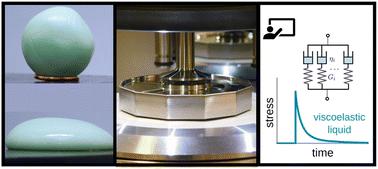当前位置:
X-MOL 学术
›
Polym. Chem.
›
论文详情
Our official English website, www.x-mol.net, welcomes your feedback! (Note: you will need to create a separate account there.)
A tutorial review of linear rheology for polymer chemists: basics and best practices for covalent adaptable networks
Polymer Chemistry ( IF 4.6 ) Pub Date : 2024-02-19 , DOI: 10.1039/d3py01367g Ralm G. Ricarte 1 , Sachin Shanbhag 2
Polymer Chemistry ( IF 4.6 ) Pub Date : 2024-02-19 , DOI: 10.1039/d3py01367g Ralm G. Ricarte 1 , Sachin Shanbhag 2
Affiliation

|
Covalent adaptable networks (CANs) are an emerging class of soft materials that combine the contradictory traits of thermosets and thermoplastics. They possess dynamic covalent cross-links between chains that exchange through a chemical reaction. Because the flow behavior of CANs reflects the interplay between the cross-link exchange kinetics and polymer backbone dynamics, careful rheological characterization is necessary to illuminate how chemical structure governs viscoelasticity. Yet, rheology presents a significant challenge for polymer chemists as an analytical technique because of the complexity of the measurement and data analysis. Considering the prevalence and significance of rheology in the field of soft matter, however, it is essential for modern polymer chemists to possess a foundation in conducting and interpreting viscoelastic experiments. This tutorial review is an introduction to linear rheology, which focuses on measurements using small strain conditions. It begins by providing a comprehensive discussion of stress relaxation, creep and recovery, and small-amplitude oscillatory shear experiments, highlighting their respective advantages and disadvantages. It explains the concepts of relaxation spectra and time–temperature superposition using simple mathematical arguments and graphical analysis. The review delves into the intricacies of polymer structure–viscoelasticity relationships, focusing on classical thermosets and thermoplastics. It also identifies common sources of experimental artifacts that affect rheology experiments. Towards the end, best practices for performing rheology on CANs are demonstrated using examples from the literature. To further enhance understanding, the review illustrates quantitative rheological models using experimental data from a commercial polymer. Supplementary spreadsheets enable readers to practice time–temperature superposition and relaxation spectrum analysis techniques.
中文翻译:

高分子化学家线性流变学教程回顾:共价适应性网络的基础知识和最佳实践
共价适应性网络 (CAN) 是一类新兴的软材料,结合了热固性塑料和热塑性塑料的矛盾特性。它们在链之间具有动态共价交联,通过化学反应进行交换。由于 CAN 的流动行为反映了交联交换动力学和聚合物主链动力学之间的相互作用,因此需要仔细进行流变表征,以阐明化学结构如何控制粘弹性。然而,由于测量和数据分析的复杂性,流变学作为一种分析技术对高分子化学家提出了重大挑战。然而,考虑到流变学在软物质领域的普遍性和重要性,现代高分子化学家必须具备进行和解释粘弹性实验的基础。本教程回顾介绍了线性流变学,重点介绍使用小应变条件的测量。首先对应力松弛、蠕变和恢复以及小振幅振荡剪切实验进行了全面讨论,强调了它们各自的优点和缺点。它使用简单的数学论证和图形分析解释了弛豫谱和时间-温度叠加的概念。该评论深入研究了聚合物结构与粘弹性关系的复杂性,重点关注经典热固性塑料和热塑性塑料。它还确定了影响流变学实验的实验伪影的常见来源。最后,使用文献中的示例演示了在 CAN 上进行流变学的最佳实践。为了进一步加深理解,该综述使用商业聚合物的实验数据说明了定量流变模型。补充电子表格使读者能够练习时间-温度叠加和弛豫谱分析技术。
更新日期:2024-02-19
中文翻译:

高分子化学家线性流变学教程回顾:共价适应性网络的基础知识和最佳实践
共价适应性网络 (CAN) 是一类新兴的软材料,结合了热固性塑料和热塑性塑料的矛盾特性。它们在链之间具有动态共价交联,通过化学反应进行交换。由于 CAN 的流动行为反映了交联交换动力学和聚合物主链动力学之间的相互作用,因此需要仔细进行流变表征,以阐明化学结构如何控制粘弹性。然而,由于测量和数据分析的复杂性,流变学作为一种分析技术对高分子化学家提出了重大挑战。然而,考虑到流变学在软物质领域的普遍性和重要性,现代高分子化学家必须具备进行和解释粘弹性实验的基础。本教程回顾介绍了线性流变学,重点介绍使用小应变条件的测量。首先对应力松弛、蠕变和恢复以及小振幅振荡剪切实验进行了全面讨论,强调了它们各自的优点和缺点。它使用简单的数学论证和图形分析解释了弛豫谱和时间-温度叠加的概念。该评论深入研究了聚合物结构与粘弹性关系的复杂性,重点关注经典热固性塑料和热塑性塑料。它还确定了影响流变学实验的实验伪影的常见来源。最后,使用文献中的示例演示了在 CAN 上进行流变学的最佳实践。为了进一步加深理解,该综述使用商业聚合物的实验数据说明了定量流变模型。补充电子表格使读者能够练习时间-温度叠加和弛豫谱分析技术。



























 京公网安备 11010802027423号
京公网安备 11010802027423号